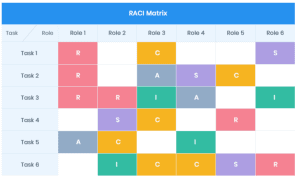What is a RACI Matrix?
The RACI matrix is a responsibility assignment chart that maps out all the tasks, milestones, or key decisions involved in completing a project and assigns which roles are responsible for each action item for which staff are responsible and, where appropriate, for whom consultation or information is required. The acronym RACI stands for the four roles that stakeholders may play in any project.
What does RACI stand for?
RACI stands for Responsible, Accountable, Consulted, Informed. Each letter in the acronym represents a level of task responsibility.
RACI Definitions
The RACI model offers structure and clarification to explain the roles of stakeholders in the project. The RACI matrix clarifies responsibilities and ensuring that everyone is assigned to do all the project needs to be accomplished.
The four roles that stakeholders might play in any project include the following:
- Responsible: People or stakeholders who are doing the work. They have to complete an objective or task or make a decision. Several people may be jointly responsible for this.
- Accountable: Stakeholder or people who are the “owner” of the work. He/she must sign off or approve when the task, decision, or objective is complete. This person must make sure that responsibilities are assigned in the matrix for all related activities. Success requires that there is at least one person Accountable, which means that “the buck stops there.”
- Consulted: Each deliverable is supported by the review and consultation of more than one member of the team. Consulted parties are usually people who provide input on the basis of either how their future project work or their area of expertise would have an impact on the deliverable itself.
- Informed: These team members just need to be kept in the project progress loop, rather than being roped in the details of every deliverable.
Benefits of RACI Chart
A RACI matrix lets you set specific standards about the functions and obligations of a project at its core. This way, you don’t have many people working on the same job or against each other because the tasks on the front end were not clearly specified.
A RACI matrix also encourages team members to take responsibility for their work or, if necessary, defer to someone else. Essentially, you will be eliminating personal judgment and politics from your process and focusing on the capacity of your team to act responsibly within a system that you developed.
Benefits of RACI Matrix
- It shows how employee workload is managed.
- It prevents the overwork of team members.
- It removes role confusion.
- It helps eliminate needless tasks.
- It is one of the good communication tools.
- It can be used for resource allocation
- It avoids conflicting assignments and responsibilities.
Disadvantages of RACI Chart
- Once it comes to changing tasks, a RACI chart lacks flexibility, and responsibility and accountability may be mixed up if they are not clearly defined.
- Complex projects make RACI charts extensive with many team members. The identification of which individual is responsible for any given task can also be difficult.
How to create a RACI Chart Matrix
- Identify all tasks involved in the delivery of the project and list them on the left side of the chart in the complete order.
- Identify all project stakeholders and list them at the top of the chart.
- Complete the model cells, identifying who is responsible, accountable, and who will be consulted and informed for each task.
- Ensure that each task has at least one stakeholder responsible for it.
- No tasks should have more than one Accountable stakeholder. Resolve any conflict where there is more than one to a particular task.
- Share, discuss, and agree on the RACI model with your stakeholders at the start of the project. This includes the resolution of any conflicts or ambiguity.
When to use a RACI matrix
A RACI chart serves just about all types of projects well. But it’s especially useful when tasks require multiple resources, run concurrently, or depend on other tasks.
Following are a few scenarios when a RACI chart comes in handy:
- The approval process or decision-making could hold up the project.
- There is conflict about decision-making or task ownership.
- The project workload feels like it’s not distributed evenly.
- You experience a team turnover and you need to quickly get someone on board for a new role.
Not all teams and projects are created equally, of course. You might work with a team that just happens to interact very well and stay at the top of their own work. Or maybe your project is small enough to make it foolish to take the time to do this exercise. Don’t think about taking the extra step in such situations.
Conclusion
The RACI matrix is a simple and elegant tool that helps all to keep track of their roles and responsibilities. This chart protects you from the confusion of roles and makes it easier to run your projects smoothly. It’s a simple and clear structure that shows who does what at a high level and can be especially helpful when creating a team charter.
Download Template
See Also
SWOT Analysis
Cost Benefit Analysis
Request of Quotation in Construction










